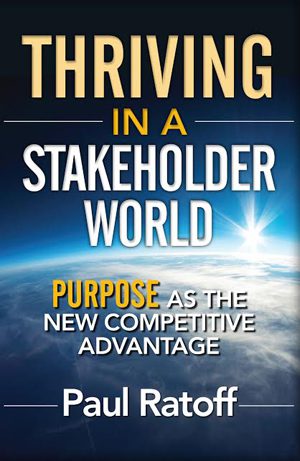
 Imagine if you could get employees to look at their jobs as something with a purpose that goes beyond just earning a paycheck. That could result in a more engaged workforce, better productivity and perhaps less turnover.
Imagine if you could get employees to look at their jobs as something with a purpose that goes beyond just earning a paycheck. That could result in a more engaged workforce, better productivity and perhaps less turnover.
A business needs a purpose and each employee needs to be inspired by and contributing to that purpose, says Paul Ratoff, president of Strategy Development Group Inc. and author of “Thriving in a Stakeholder World: Purpose as the New Competitive Advantage.”
Ratoff is a Certified Management Consultant and founder of the Foundation for Purposeful Organizations. He has been a successful business consultant in Southern California for 35 years.
“If everyone in an organization feels good about the work they do and is committed to the organization’s purpose, then you’re likely to see good results,” says Ratoff, who recently launched the non-profit Foundation for Purposeful Organizations. “But if workers aren’t engaged, their productivity can suffer and the company as a whole may pay the price.”
For years, many companies chased quarterly earnings and ignored any overarching purpose beyond keeping shareholders happy. But Ratoff believes that to survive and thrive in today’s world, businesses need to think about more than just “shareholder value.”
 Instead, he says, company leaders need to manage from the perspective of “stakeholder value,” and stakeholders include everyone who impacts the company or is impacted by it, from customers to suppliers to communities. Among the key stakeholders: the employees.
Instead, he says, company leaders need to manage from the perspective of “stakeholder value,” and stakeholders include everyone who impacts the company or is impacted by it, from customers to suppliers to communities. Among the key stakeholders: the employees.
But once a company comes up with a purpose, how does it get employee buy-in?
• It starts at the top. It’s not enough that employees find the purpose inspiring. “The leader of the company has to be inspired because the leader will cause others to be inspired.” Ratoff says. Ultimately, it’s important that the entire management team be on board and enthusiastic.
• Make sure the purpose is clear and meaningful. Company leaders must find a common purpose that’s broad enough to be meaningful and important to employees. In the absence of a clear organizational purpose, people focus on their individual goals and may perceive different purposes for the same organization.
• Discard what doesn’t fit. Identify company activities that aren’t aligned with the purpose and remove or transform them.
“Purpose isn’t an idea that only lives in a strategic plan or on a website,” Ratoff says. “It lives in the daily operation of a business and in the ongoing communications with stakeholders. And it lives as the internal compass for keeping a complicated organization with many competing interests on course.”



